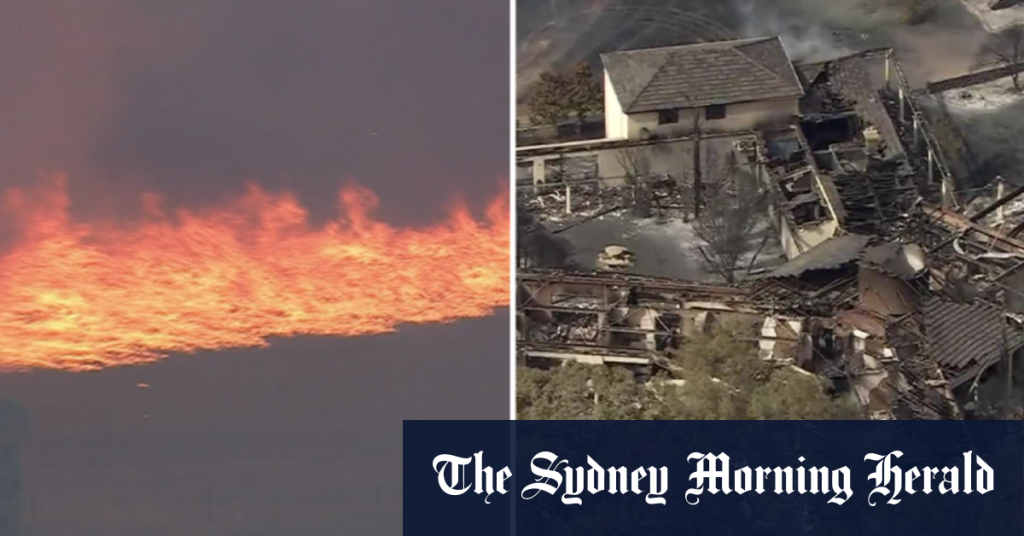Paragraph 1: The Outbreak and Initial Impact
A devastating bushfire erupted in the northeastern region of Perth, Western Australia, on January 2, 2025, rapidly engulfing the landscape and threatening homes and livelihoods. The fire’s intensity and speed caught many residents off guard, forcing evacuations and creating a sense of urgency among emergency responders. Early reports confirmed the destruction of one home, a stark illustration of the fire’s destructive power. Dozens of other structures sustained damage, ranging from minor scorch marks to significant structural compromise. The ferocity of the blaze was fueled by dry conditions and strong winds, making containment efforts challenging. As the fire raged, thick smoke plumes billowed into the sky, casting a pall over the affected area and impacting air quality across a wider region.
Paragraph 2: Emergency Response and Evacuation Efforts
Firefighting crews from across the region mobilized swiftly, battling the inferno with a combination of ground crews and aerial support. Water bombers and helicopters worked tirelessly to douse the flames from above, while firefighters on the ground established containment lines and protected properties in the fire’s path. Emergency services issued urgent evacuation orders for residents in the most threatened areas, directing them to designated safe havens. The scale of the evacuation underscored the immediate danger posed by the rapidly spreading fire. Community centers and schools were transformed into temporary shelters, providing refuge for displaced residents and offering essential supplies. The coordinated response of emergency services and community organizations demonstrated a collective effort to mitigate the impact of the disaster.
Paragraph 3: Community Impact and Support Networks
The bushfire’s impact reverberated throughout the affected communities, leaving residents grappling with loss and uncertainty. The destruction of homes and property represented a significant setback for many families, leaving them to confront the arduous task of rebuilding their lives. The emotional toll of the disaster was profound, with residents experiencing anxiety, fear, and grief. Community support networks quickly emerged, offering assistance to those displaced by the fire. Neighbors helped neighbors, sharing resources, providing emotional support, and assisting with evacuation efforts. Local businesses and organizations stepped forward to donate food, clothing, and other essential items to those in need, demonstrating the resilience and compassion of the community in the face of adversity.
Paragraph 4: Ongoing Firefighting Operations and Containment Strategies
As the fire continued to burn, firefighters maintained a relentless effort to contain the blaze and prevent further damage. Crews worked around the clock, battling challenging terrain and unpredictable weather conditions. Strategic backburning operations were employed to create firebreaks and starve the fire of fuel, a critical tactic in controlling its spread. Constant monitoring of weather patterns and fire behavior was essential for adapting firefighting strategies and ensuring the safety of personnel. The dedication and expertise of the firefighters were paramount in mitigating the impact of the disaster and protecting remaining properties.
Paragraph 5: Assessing the Damage and Looking Ahead
Once the fire was brought under control, the daunting task of assessing the full extent of the damage began. Surveys of the affected areas were conducted to document property losses, infrastructure damage, and environmental impact. The initial reports of one home destroyed and dozens of structures damaged only hinted at the broader devastation wrought by the fire. The loss of natural habitats and wildlife was also a significant concern, requiring careful assessment and long-term restoration efforts. As the community began the process of recovery, the focus shifted towards rebuilding homes, restoring infrastructure, and providing ongoing support to affected residents.
Paragraph 6: Lessons Learned and Fire Prevention Strategies
The devastating bushfire served as a stark reminder of the ever-present threat of wildfires in Australia, particularly during periods of dry and hot weather. The incident highlighted the importance of community preparedness, early warning systems, and effective fire prevention strategies. The need for adequate resourcing of firefighting services and the development of comprehensive bushfire management plans were underscored by the scale and intensity of the fire. The experience also emphasized the importance of community education and awareness campaigns to promote fire safety and encourage proactive measures to reduce fire risk. The lessons learned from this bushfire will inform future strategies for preventing and mitigating the impact of such disasters, contributing to greater community resilience and safety.

